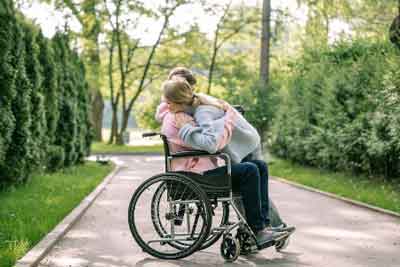Having a family member with a disability can be challenging. Home modifications, assistive equipment and technology, and other investments may be needed to ensure that they are safe and comfortable in their living environment, as well as equipped with the tools they need to accomplish their daily tasks.
Here are the top home investments that can make the lives of disabled family members easier.
1. Wheelchair lifts
They are a great investment for making home access easier. They provide access to different levels of the house, such as from the ground floor to upstairs bedrooms and bathrooms, without having to use stairs.
They can also save time and energy that would otherwise be spent carrying or pushing a wheelchair upstairs. Additionally, wheelchair lifts can be customized to fit any home, making them a great choice for disabled family members.
It’s important to make sure that they are properly installed and meet safety standards. Also, make sure to check with an occupational therapist or other healthcare professional to determine the best size, type, and installation location for the lift.
2. Bathroom modifications
Making the bathroom accessible for wheelchair users or adding grab bars can be a great investment for family members with disabilities.
Installing a walk-in bathtub, raising the toilet seat, and adding lever door handles are just some of the simple home modifications that can help make life easier for disabled family members.
Additionally, these modifications can increase safety and improve accessibility in the bathroom. It’s important to consult a healthcare professional or occupational therapist for advice on what modifications will work best for your home.
This will help ensure that your disabled family member is comfortable and safe when using the bathroom.
3. Accessible kitchen
Cooking is a huge part of daily life, so making sure your kitchen is easily accessible to those with limited mobility is essential.
Widening doorways between rooms to allow wheelchairs and other assistive devices to access them more efficiently, installing lower countertops and cabinets, and replacing traditional appliances with versions that are easier to use can all go a long way in helping disabled family members feel comfortable in the kitchen.
If possible, it would be helpful to install appliances that are voice- or motion-activated so they can easily access them.
4. Home automation and assistive technology
Investing in home automation and assistive technology can make life easier for disabled family members. Smart technology, such as voice-activated lights, automated doors and windows, and smart appliances can help them complete their tasks more quickly and efficiently.
Additionally, telehealth devices allow doctors to monitor the health of disabled family members from a distance, making sure they are safe and healthy while living at home.
There are also many other types of assistive technologies available that can help disabled individuals with daily activities like communication and mobility. It’s important to research these options before investing so you can find the best device for your needs.
5. Home security
When caring for someone with a disability, home security is an important consideration. Installing an alarm system or surveillance cameras can help provide peace of mind while also keeping your home and family safe.
Additionally, installing motion-activated lights and outdoor lighting can deter intruders and help you better monitor the activity around your home. It’s important to make sure that these safety features are easy to use for those with limited mobility so they can access them if needed.
Also, check with your local authorities to determine what home security features are allowed in your area.
6. Home accessibility ramps
Installing a ramp in your home can provide easier access for those with limited mobility. Ramps can help disabled family members get around their homes more easily and can be designed to fit any space.
Consider installing a ramp in multiple areas of your home for added convenience, such as at the entrance or over the stairs. It’s essential to make sure that the ramp meets safety standards and is constructed from durable materials to ensure its longevity.
Additionally, you may want to consult a healthcare professional or occupational therapist for advice on the best type of ramp for your needs.
By making these investments, you can help make life easier for disabled family members and create an environment where they feel comfortable and safe in their own homes.
Having access to assistive technology, home security systems, ramps, bathroom modifications, and accessible kitchens can all go a long way toward ensuring that disabled individuals have the support they need while living independently.
With the right investments, you can ensure that your disabled family member is safe and comfortable in their own home.





No Comments